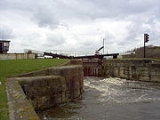
James Abernethy
Encyclopedia
James Abernethy FRSE (12 June 1814 – 8 March 1896) was a Scottish civil engineer
.
Abernethy was born in Aberdeen
to George Abernethy. As a boy, James assisted his father on the extension of the London docks. He later worked as an engineer and ironfounder
, his primary area of work being bridges and marine engineering. His works include the South Dock and Half Tide Basin of Swansea Marina
, Tennant Canal
, Aire and Calder Navigation
, New Junction Canal
and many bridges in Scotland. He designed and built the Canale Cavour in Italy
.
He was instructed by the Lords of the Admiralty to arbitrate in the complicated case over the developments at Watchet Harbour in October and November 1856.
He was president of the Institution of Civil Engineers
between December 1880 and December 1881. He was also made a fellow
of the Royal Society of Edinburgh
. He died at Broadstairs
, Kent
on 8 March 1896, his first son James taking over the engineering practice and his second son John compiling his biography in 1897.
Civil engineer
A civil engineer is a person who practices civil engineering; the application of planning, designing, constructing, maintaining, and operating infrastructures while protecting the public and environmental health, as well as improving existing infrastructures that have been neglected.Originally, a...
.
Abernethy was born in Aberdeen
Aberdeen
Aberdeen is Scotland's third most populous city, one of Scotland's 32 local government council areas and the United Kingdom's 25th most populous city, with an official population estimate of ....
to George Abernethy. As a boy, James assisted his father on the extension of the London docks. He later worked as an engineer and ironfounder
Foundry
A foundry is a factory that produces metal castings. Metals are cast into shapes by melting them into a liquid, pouring the metal in a mold, and removing the mold material or casting after the metal has solidified as it cools. The most common metals processed are aluminum and cast iron...
, his primary area of work being bridges and marine engineering. His works include the South Dock and Half Tide Basin of Swansea Marina
Swansea Marina
Swansea Marina is a marina located behind the Swansea barrage at the mouth of the River Tawe in Swansea, south Wales. Swansea Marina was awarded blue flag status in June 2005 and has been awarded five gold anchors by the Yacht Harbour Association...
, Tennant Canal
Neath and Tennant Canal
The Neath and Tennant Canals are two independent but linked canals in South Wales that are usually regarded as a single canal. The Neath Canal was opened from Glynneath to Melincryddan, to the south of Neath, in 1795 and extended to Giants Grave in 1799, in order to provide better shipping...
, Aire and Calder Navigation
Aire and Calder Navigation
The Aire and Calder Navigation is a river and canal system of the River Aire and the River Calder in the metropolitan county of West Yorkshire, England. The first improvements to the rivers above Knottingley were completed in 1704 when the Aire was made navigable to Leeds and the Calder to...
, New Junction Canal
New Junction Canal
The New Junction Canal is a canal in South Yorkshire, England. It is part of the Sheffield and South Yorkshire Navigation , although it was jointly funded by the Aire and Calder Navigation, and was opened in 1905. It links the River Don Navigation and the Stainforth and Keadby Canal with the Aire...
and many bridges in Scotland. He designed and built the Canale Cavour in Italy
Italy
Italy , officially the Italian Republic languages]] under the European Charter for Regional or Minority Languages. In each of these, Italy's official name is as follows:;;;;;;;;), is a unitary parliamentary republic in South-Central Europe. To the north it borders France, Switzerland, Austria and...
.
He was instructed by the Lords of the Admiralty to arbitrate in the complicated case over the developments at Watchet Harbour in October and November 1856.
He was president of the Institution of Civil Engineers
Institution of Civil Engineers
Founded on 2 January 1818, the Institution of Civil Engineers is an independent professional association, based in central London, representing civil engineering. Like its early membership, the majority of its current members are British engineers, but it also has members in more than 150...
between December 1880 and December 1881. He was also made a fellow
Fellow
A fellow in the broadest sense is someone who is an equal or a comrade. The term fellow is also used to describe a person, particularly by those in the upper social classes. It is most often used in an academic context: a fellow is often part of an elite group of learned people who are awarded...
of the Royal Society of Edinburgh
Royal Society of Edinburgh
The Royal Society of Edinburgh is Scotland's national academy of science and letters. It is a registered charity, operating on a wholly independent and non-party-political basis and providing public benefit throughout Scotland...
. He died at Broadstairs
Broadstairs
Broadstairs is a coastal town on the Isle of Thanet in the Thanet district of east Kent, England, about south-east of London. It is part of the civil parish of Broadstairs and St Peter's, which includes St. Peter's and had a population in 2001 of about 24,000. Situated between Margate and...
, Kent
Kent
Kent is a county in southeast England, and is one of the home counties. It borders East Sussex, Surrey and Greater London and has a defined boundary with Essex in the middle of the Thames Estuary. The ceremonial county boundaries of Kent include the shire county of Kent and the unitary borough of...
on 8 March 1896, his first son James taking over the engineering practice and his second son John compiling his biography in 1897.

